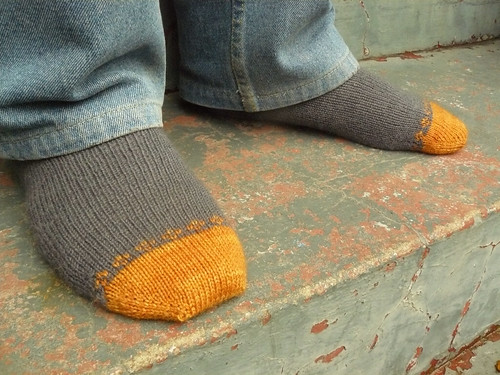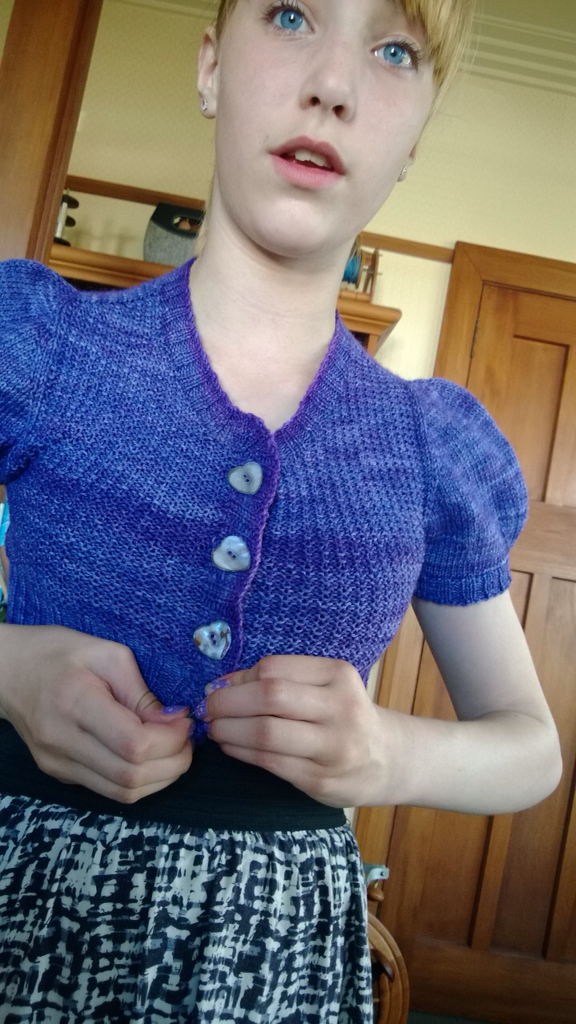Today's post is a review of the Fish Lips Kiss Heel (FLK), a pattern sold on Ravelry for $1 (USD). I knit a pair of socks using the instructions in the FLK pattern for Bear, and he has worn them, the socks have been washed, and worn again - this review comprises my thoughts having knit them and his having worn them.
You may have seen the hype, the buzz, the chat about this pattern. The FLK heel is marketed on being a new and different approach to not only working the heel, but to fitting a hand knit sock. I will discuss that aspect first, as the fit is determined before the heel is turned, then I will talk about the heel, and make some comments on the pattern and support.
The author presents a method where the sock is customized to the foot it is knit for, and provides a system that is based on a tracing of the foot. The method is explained in great detail, even to instructions of how to trace the foot, what pen to use, and how to stand, and what makes a good tracing to work from. There is a little bit of math, nothing scary, simple addition and division, based in measurements that come from the foot tracing. Then you cast on ...and knit. The pattern is full of promises about further updates, which will include a toe that is simillar to the heel, but for now uses a straightworward and simple toe with increases each end of the sole and topside. The number is stitches you need to fit is determined by slipping the toe over a cut out of the foot tracing ... And you stop increasing at a recognizable point, the work the sock straight until you reach a line determined by your earlier calculation. All this is very simple - but seems to take forever to explain in the pattern. I love the way EZ wrote patterns, a longer version that explained the reasoning and the maths, and a 'short and pithy' version that just explained quickly how to work the item, and feel that a simillar approach would be great for the FLK heel.

As for turning the heel, this is a rather simple and straightworward method, based on short rows and worked with twin stitches instead of wraps, japanese short rows, yarn overs, any other method I have seen or workd. The twin stitches are clearly explained and easy to work, the method for the heel is methodical, so much so that after working one heel it is pretty easy to work the second without the pattern being to hand. I like this method of short rowing and think it may become my method of choice, the turns are firm and there is no bulk or weird distorted stitches. The author writes that the short rows melt into the fabric - and they do. The author provides further advice about working the heel for a patterned sock, so that the heel retains its fit as designed. I suspect this is a visual trick of the method, adjusting where the pattern starts above the heel so the sock looks like it fits, and it's not a bad trick to use and know a about to easily improve how a sock fits.

I did nothing special to work these short row other than follow the pattern instructions and love the way they feel to work, and the way they work and look.
I am surprised at the fit of these socks, I usually knit bear a 68 or 72 stitch sock and yet using the instructions for FLK this sock only needed 60 stitches. The method relies on negative ease to hug the foot, and heel method provides enough depth for the sock to be easily worn without resort to a gusset - I'm impressed!
I told Bear the socks were ’different' and that I was knitting using a new pattern for the heel - and asked for his comments. He said they fit fine, amongst the best he has, and that there is no problem at all with the fit or sizing, the heel sits nicely. He stopped short of waxing lyrical, but clearly found the socks ok, maybe better than ok.
The next stage is to knit a pair for me, up until now I haven't found short row heels to my liking, prefering the snug fit of a slip stitched flap and gusset heel. I have narrow heels and maybe the pull in a classic slip stitch provides feels right - but I'm prepared to see how this pattern feels on my feet. Following that I want to knit a pair for my brother or dad - some one I can trace the foot of and test the method without them being around.
The pattern is only a dollar, and for the twin stitch instructions is worth that price to learn a new short row method. At fifteen pages the purchased pattern is long, and is mix of explanation, justification, sales and marketing, and promises along with the details of the method - I'm having mixed feeling about that. I do like knowing the thinking behind the method, but can't help feeling the presentation is clouded by all of that being mixed together. The pattern has a good following on ravelry, and it's on group where the designer and those who have knit several and have experience are on hand to trouble shoot. Within that group there is a lot of positive encouragement, if a first sock isn't quite right a communal cry of `well it's a small problem, and the heel is so quick and easy you will be able to rip back and rework with these changes in no time'. They are right, the heel is quick and easy, and as the sock fits with fewer stitches than usual - knitting speeds by. And much of the advice seems to correct novices who have overthought the method and added length or stitches or a gusset even - assuming that as those things are needed when they knit socks usually - they must also add them to the FLK heel sock. Not so it seems, knit the sock as instructed and all will be well the forum posts suggest. The author is clearly generous in her pricing, and is clear that she is keen to see people find and like her heel, she is also protective - any posts that she considers to contain copyrighted details are edited with a note explaining such. I did have one question, posted it on the forum and thought I worded the question to avoid giving away details of the method or pattern - but apparently not, my post was edited, and details removed, as well as my question being quickly and politely answered. I'm cool with that, copyright is copyright, and the sock method is someone's IP.
Should you buy the pattern and try it, maybe, I bought the pattern and knit a pair to see if the heel was worth the hype - and I am left thinking maybe it is. The pattern, the fit, the heel all surprise me in how well it works - almost in opposition to much I thought I knew about knitting short row heel socks. I am aware that several knitters of socks have bought the pattern but find the length and presentation (wordiness ) more than they want to deal with, and have set it aside without knitting it.
What do you think? Have you knit some, bought the pattern, or even visited the forum to see what it's all about?
Na Stella















